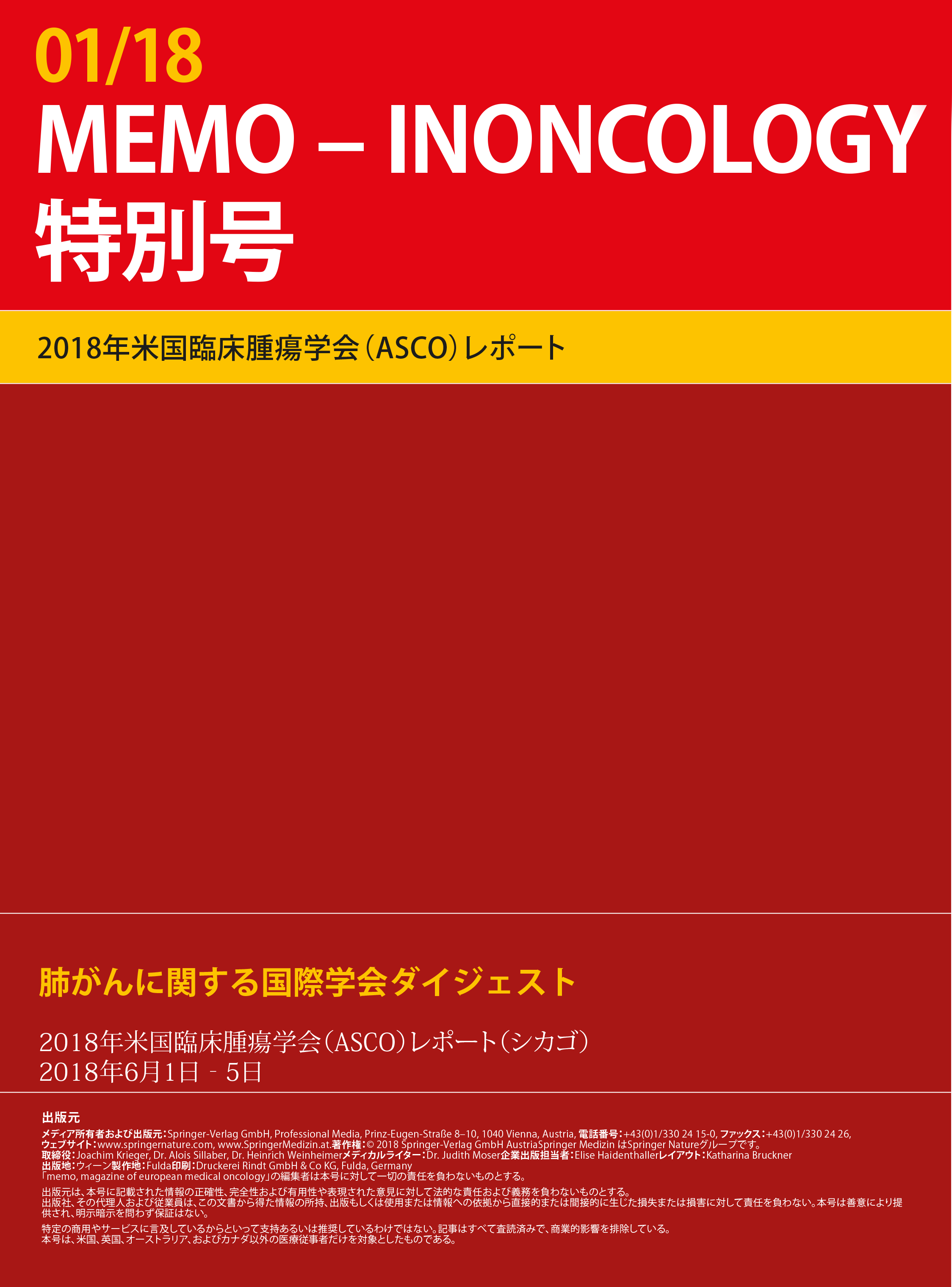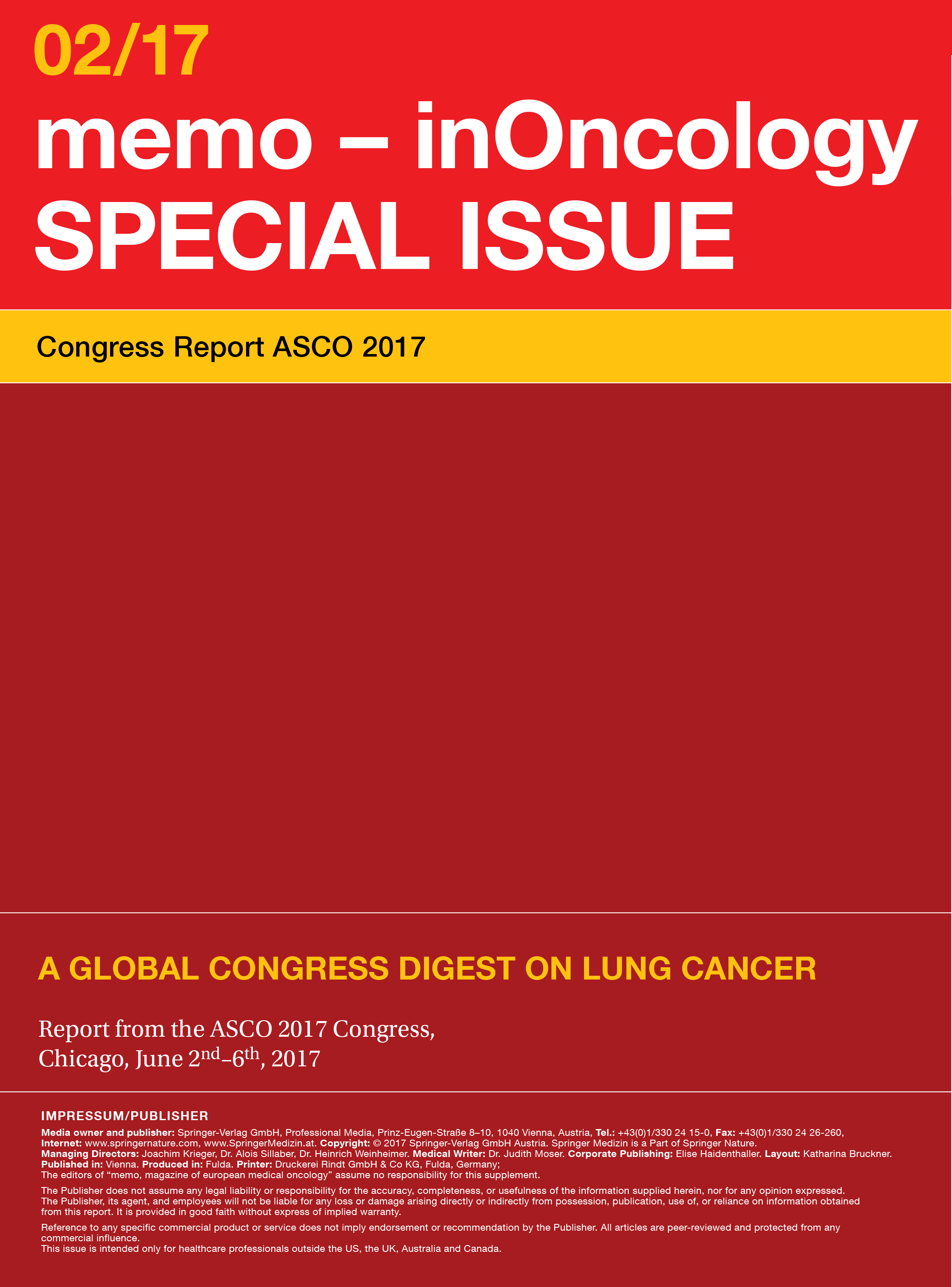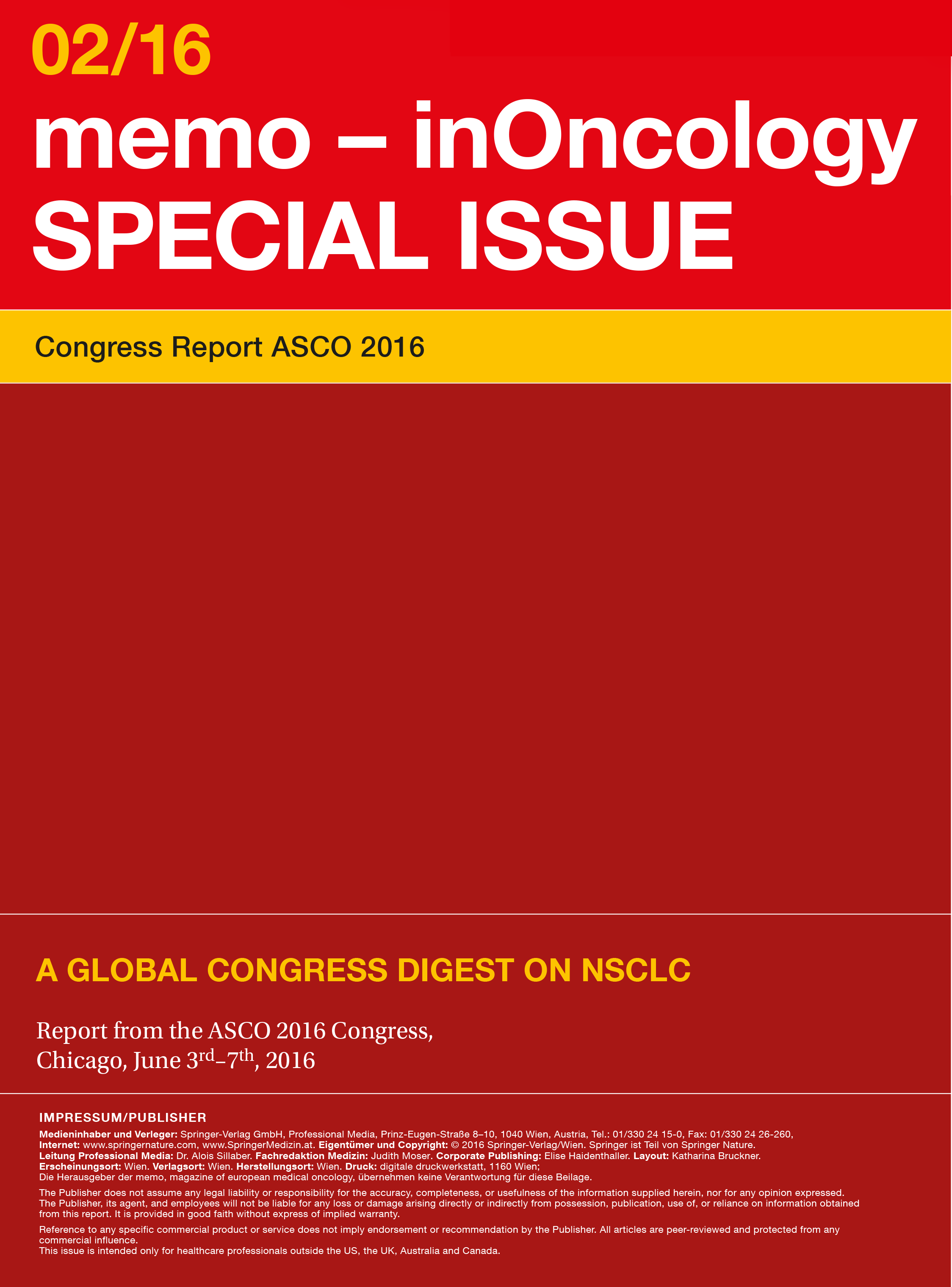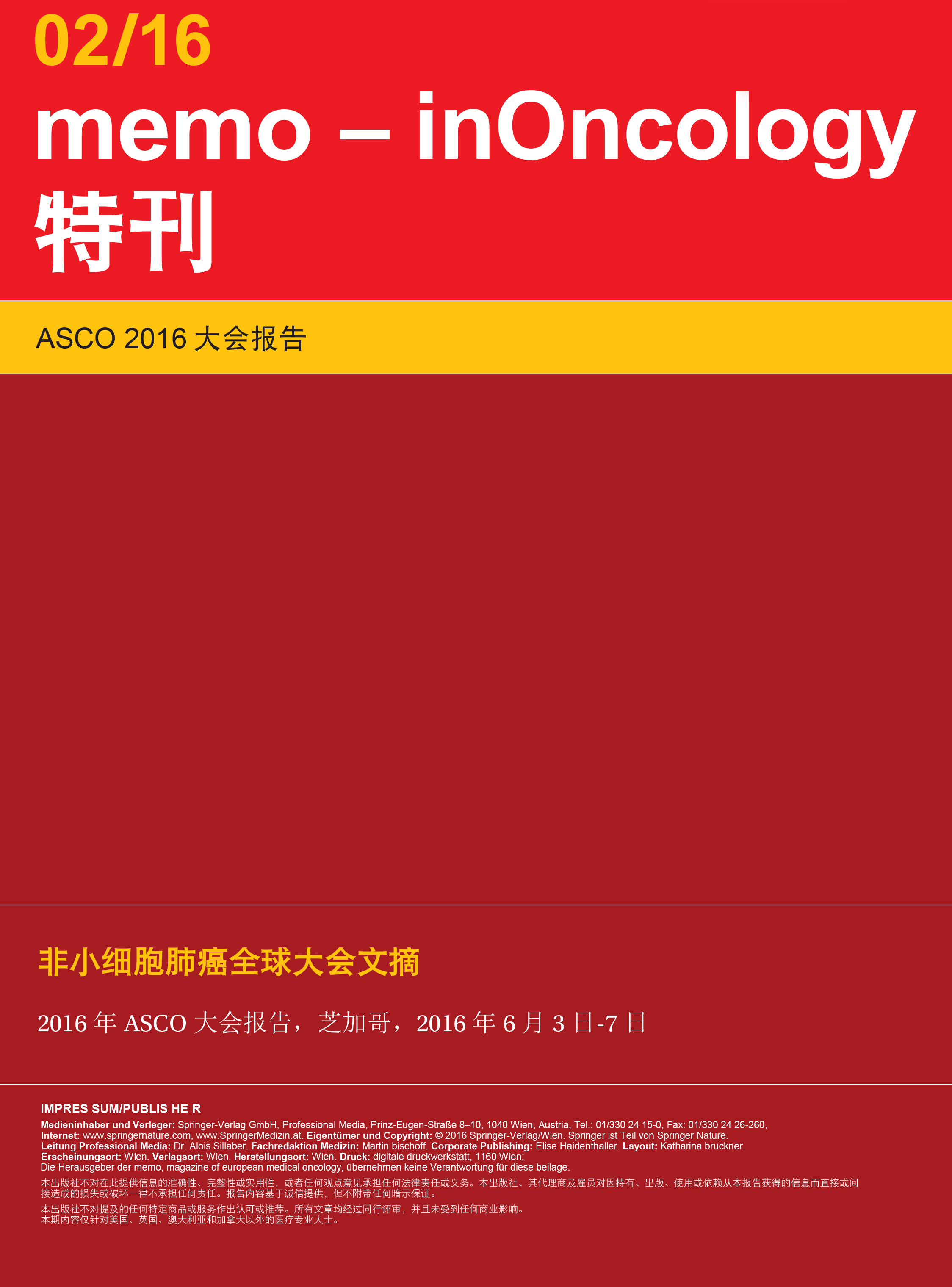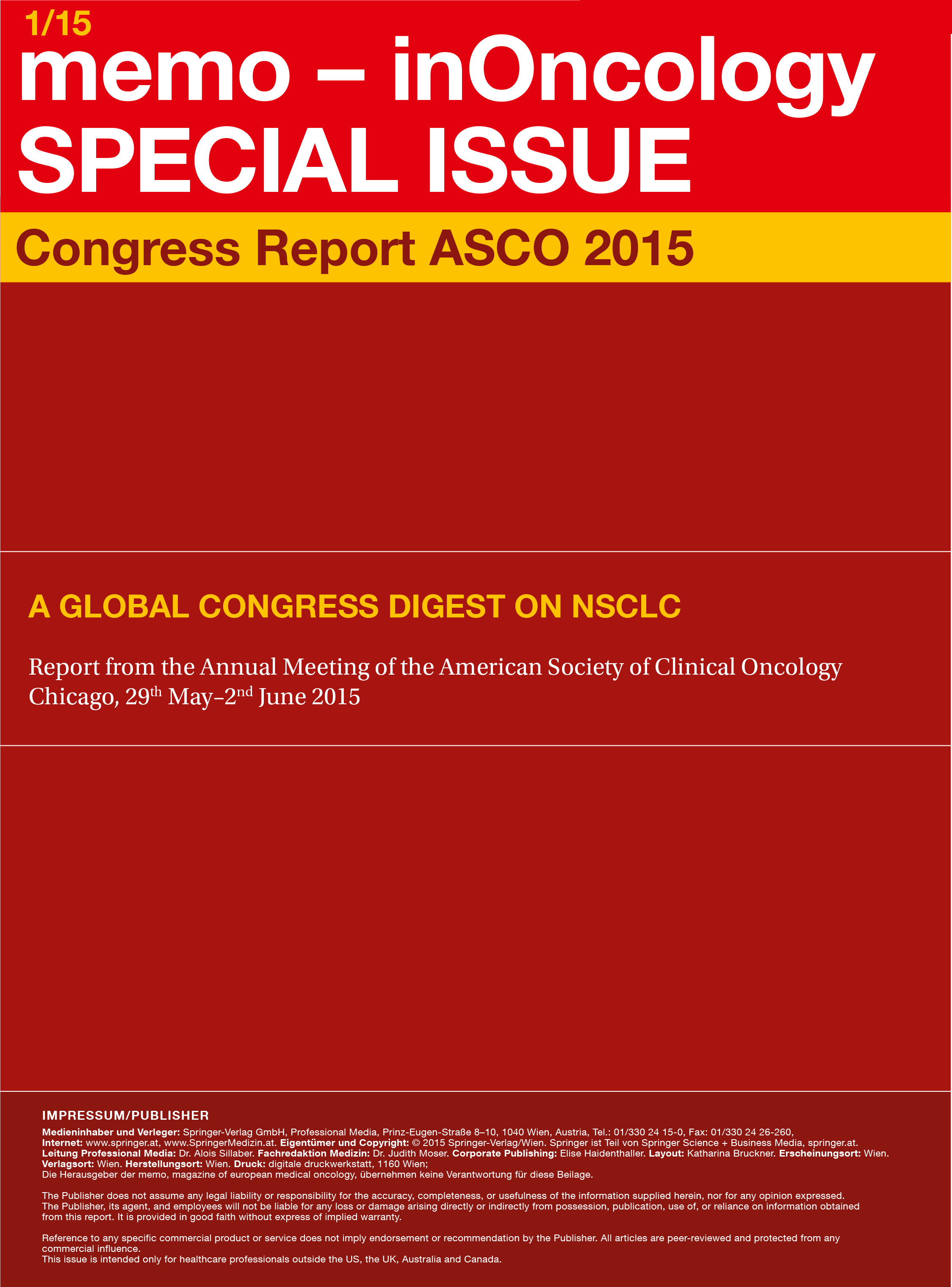ASCO 2019 – Chicago
Lecture Board: Rafał Dziadziuszko, MD, PhD; Enriqueta Felip, MD, PhD; Maximilian Hochmair, MD; Sanjay Popat, PhD, FRCP;
Elisabeth Quoix, MD
Medical Writer: Dr. Judith Moser
Preface – ASCO 2019
Lung cancer is still a global public health problem and the first cause of cancer-related mortality everywhere in the world. Nowadays, this has particular implications for elderly patients considering the generally increasing life expectancy in conjunction with the rising cancer incidence with age. At the time of diagnosis, the median age of patients with lung cancer is 70 years in the USA and 65 to 70 years in Europe.
Early-stage NSCLC: promising (neo)adjuvant approaches
Effective treatment options are called for in patients with resectable non-small-cell lung cancer (NSCLC), as more than half of those with stage I to III disease experience relapses [1]. Chen et al. demonstrated in their animal model that tumor PD-L1 upregulation is critical for the spread and survival of metastases [2]. Based on these considerations, several clinical trials are investigating the potential benefits of immunotherapies in the neoadjuvant setting.
Novel first-line options and other insights in EGFR-mutant lung cancer
Although treatment with EGFR TKIs is generally efficient in patients with EGFR-mutant lung cancer, resistance inevitably develops within 8 to 12 months of the initiation of therapy, leading to treatment failure. Therefore, there is an unmet need for options that extend the activity of EGFR-targeted therapies. Dual blockade of the VEGF and EGFR signaling pathways represents a potential approach in this respect.
Trial updates and new biomarkers in the field of immunotherapy
KEYNOTE-001 was the first trial to demonstrate the activity of the PD-1 inhibitor pembrolizumab in patients with treatment-naïve or previously treated advanced NSCLC. Notably, in this multicohort phase IB study, pembrolizumab showed greater activity with increasing PD-L1 tumor proportion score (TPS). Between May 2012 and July 2014, 550 patients with advanced NSCLC had been enrolled across 4 non-randomized and 2 randomized cohorts.
Interview: Blood-based testing in ALK-positive disease
What can we expect from circulating free DNA (cfDNA) as a biomarker in the setting of lung cancer diagnosis and treatment today?
Rare mutations: taking treatment one step further
MET exon 14 skipping mutations (METex14) have been reported in 3 % to 4 % of NSCLC patients. They confer poor prognosis and poor responses to standard therapies including immunotherapy. Moreover, patients with MET alterations are generally older, which implies that tolerable strategies are called for. Capmatinib has been developed as a highly selective, potent MET inhibitor with in vitro and in vivo activity against preclinical cancer models harboring MET activation.
Small-cell tumors: improvements in the second-line setting
Only limited therapeutic options are available for patients with relapsing small-cell lung cancer (SCLC). Topotecan is the only FDA-approved treatment for platinum-sensitive disease in the second-line setting. However, it induces merely modest clinical benefits, while at the same time giving rise to significant hematological toxicity.
Expansion of clinical trial enrollment criteria: what would we gain?
In 2017, the American Society of Clinical Oncology and the non-profit organization Friends of Cancer Research noted in their joint statement that trial enrollment criteria should strive for inclusiveness to make trial populations more representative and to maximize generalizability of findings. Also, this would enable more patients to participate and accelerate accrual, resulting in expedited availability of new therapies.
序言
亲爱的同事们, 肺癌仍然是全球性的公共健康问题,也是世界各地癌症相关死亡的首要原因。考虑到预期寿命的普遍延长和癌症发病率随年龄的增加,如今这一情况尤其需要老年患者的注意。肺癌患者确诊的中位年龄在美国为70岁,在欧洲为65至70岁。鉴于正在经受测试或已经在临床实践中确立的众多治疗选择,可以肯定地说,对于当今的老年人群而言不会缺少治疗手段。同时,进一步提高治疗耐受性和个性化的必要性毋庸置疑。
早期NSCLC:有前景的(新)辅助方法
可切除非小细胞肺癌(NSCLC)患者需要有效的治疗选择,因为超过半数的I期至III期疾病患者经历复发。Chen等人在他们的动物模型中证明,肿瘤PD-L1上调对转移的扩散和存活至关重要。基于这些考虑,一些临床试验正在研究免疫疗法在新辅助条件下的潜在获益。 随机化II期NEOSTAR试验包括44名患有I期至IIIA期NSCLC的手术候选者[3]。将他们随机分配为在第1天、第15天和第29天接受3个剂量的3mg/kg纳武单抗(nivolumab),或者接受相同的纳武单抗方案并在第1天添加1 mg/kg易普利姆玛(ipilimumab)。
EGFR突变肺癌的新一线选择和其他见解
尽管EGFR TKI治疗通常对EGFR突变肺癌患者有效,但耐药性在治疗开始后8到12个月内不可避免地出现,导致治疗失败。因此,对延长EGFR靶向疗法活性的选项存在未满足的需求。VEGF和EGFR信号传导途径的双重阻断代表这方面的一种潜在方法。 全球性随机化安慰剂对照的III期RELAY试验在IV期EGFR突变阳性(即,外显子19缺失、外显子21 L858R突变)NSCLC患者中测试了第一代EGFR TKI厄洛替尼(erlotinib)与抗VEGFR-2抗体雷莫芦单抗的组合作为一线策略。
免疫疗法领域的试验更新和新生物标志物
KEYNOTE-001是证明PD-1抑制剂派姆单抗在初治或先前治疗的晚期NSCLC患者中的活性的首项试验。值得注意的是,在此项多队列IB期研究中,派姆单抗随着PD-L1肿瘤比例评分(TPS)的增加而显示更高的活性。在2012年5月至2014年7月间,共有550名晚期NSCLC患者参与了4个非随机队列和2个随机队列。其中101人是初治的,449人接受过治疗。Garon等人在2019年ASCO大会上报告了KEYNOTE-001的5年疗效和安全性结果。
ALK阳性疾病基于血液的检测
基于血液的诊断可用于肺癌诊断领域,也可用于评价预测性分子改变。如今,根据肺癌患者DNA中的单个畸变将患者划分为许多小型的亚组。借助现代技术,我们不仅可以诊断组织中的这些改变,还可以诊断患者血液中的这些改变。非常有趣的是可以看到,基于血液的检测的诊断准确性正在提高,可高达80 %甚至90 %。这些测试可用于初始诊断和靶向药物的选择,包括免疫疗法,并且还可能用于治疗监测。
罕见突变:使治疗更进一步
据报道,3 %至4 %的NSCLC患者具有MET外显子14跳跃突变(METex14)。这些突变意味着不良的预后,以及对包括免疫疗法在内的标准治疗的应答较差。此外,具有MET异常的患者通常年龄较大,这意味着需要耐受性更好的策略。Capmatinib已被开发作为高选择性的有效MET抑制剂,针对携带MET活化的临床前癌症模型具有体外和体内活性。
小细胞肿瘤:二线条件下的改善
对于复发性小细胞肺癌(SCLC)患者,仅可获得有限的治疗选择。拓扑替康(topotecan)是唯一经FDA批准的,用于在二线条件下对铂敏感性疾病的治疗。然而,其仅引起中等的临床获益,但同时导致显著的血液学毒性。 一种新型方法可能源起于下调致癌转录因子的抑制。已发现SCLC是转录成瘾肿瘤。Rudin等人描述了由四种关键转录调节因子的差异表达定义的四种分子SCLC亚型。Lurbinectedin是一种致癌转录的选择性抑制剂,通过与DNA结合起作用。
扩展临床试验入选标准:我们将有何收获?
2017年,美国临床肿瘤学会和非营利组织癌症研究之友在其联合声明中指出,试验入选标准应力求包容性,以使试验人群更具代表性,并最大限度地提高研究发现的普适性。此外,这将使得更多患者能够参与并加速研究进行,从而加快新疗法的面世。 Harvey等人使用2011年1月至2018年12月期间获得的现实数据进行了回顾性研究,以证明扩大标准与传统标准对晚期NSCLC患者资格的影响。基于ASCO CancerLinQ Discovery(CLQD)去识别的电子健康记录,鉴别出在诊断为晚期NSCLC后接受治疗的患者。
巻頭言
肺がんが今日でも世界の公衆衛生上の問題であり、各国でがん関連の死因として最も多い疾患です。寿命の全体的な延びに伴い、がんの発生率も上昇していることから、最近ではとりわけこの点が高齢者にとって意味を持ってきています。肺がん患者が診断を受けた年齢の中央値は、米国では70歳、ヨーロッパでは65から70歳となっています。有効性や安全性を検討していたり、それが臨床現場ですでに証明されていたりする治療法が数多くあることを考えると、高齢患者への治療に意味はないと考える余地はないと言えるでしょう。
早期NSCLC:期待を持てる(ネオ)アジュバント療法
切除可能な非小細胞肺がん(NSCLC)のⅠ期からⅢ期と診断された患者の半数以上は再発するため、効果の高い治療法が求められている[1]。転移巣の広がりと転移後の生存にはPD-L1のupregulationが非常に重要になることを、Chenらが動物モデルを参照して示した[2]。この点を念頭に置いて、ネオアジュバント療法に免疫療法を行った場合の有効性などを、複数の臨床試験で検証している。
EGFR遺伝子変異陽性肺がんへの新規第一選択薬およびその他の知見
EGFR遺伝子変異陽性肺がん患者には、EGFR TKIがおおむね有効だが、投与開始後8~12か月以内に耐性を獲得することは避けられず、治療がうまくいかない原因となっている。EGFR阻害薬の活性を延長させる選択肢のないところが、アンメットニーズになっている。VEGFとEGFRのシグナル伝達経路をダブルでブロックする方法が、このアンメットニーズへの解決策になる可能性がある。
臨床試験の最新結果および免疫療法の新規バイオマーカー
KEYNOTE-001試験は、進行NSCLCの治療歴のない患者と治療歴のある患者に抗PD-L1抗体薬ペムブロリズマブの作用が見られた、初の臨床試験である[1]。このマルチコホート第IB相試験では、腫瘍細胞のうちPD-L1発現が陽性になる細胞の割合を表すTPSがペムブロリズマブ群で上昇し、より大きな効果が示された。2012年の5月から2014年の7月にかけて、進行NSCLC患者550人が非ランダム化比較試験の4試験と、ランダム化比較試験の2試験の患者コホートとして組み入れられた。
ALK融合遺伝子陽性NSCLCにおける血液検体を用いたリキッドバイオプシー
血液検体を用いる診断検査というのは肺がんの診断だけでなく、遺伝子変異の予測にも利用できます。肺がんの場合は現在、患者個人のDNAにどのような変異があるかによって、細かくいくつものサブグループに分類しています。現在の技術をもってすれば、組織中の遺伝子変異はもとより血液中の遺伝子変異も検出可能です。
まれな遺伝子変異:治療を一歩先へ進める
NSCLC患者の3%から4%にMETエクソン14スキップ変異(METex14)を認める、という報告がある。この遺伝子変異は予後だけでなく、免疫療法といった標準治療への反応が不良になることと関係している。その上、MET遺伝子変異のある患者は高齢であることが多いため、忍容性を改善する対策が必要になる。カプマチニブは、非常に高い選択性とMET阻害作用を持つ薬剤として開発されており、MET遺伝子変異を生じさせたがん動物モデルに対してin vitroとin vivoの両方で効果を示している。
小細胞肺がん:セカンドライン治療の改善
再発性小細胞肺がん(SCLC)患者への治療の選択肢は非常に限られている。プラチナ製剤感受性肺がんのセカンドライン治療に、米食品医薬品局が承認した治療薬はトポテカンだけであるが、臨床的有用性が思わしくない割には、重度の血液学的毒性を引き起こしている。 活性化した発がん性転写因子を抑制することが新薬の開発につながるかもしれない。SCLCは転写因子に依存する腫瘍であることが分かっている。Rudinらが、4種類の主な転写制御因子の発現差異別に、SCLCの遺伝子のサブタイプを分類した。
臨床試験の選択基準の緩和:われわれにとっての利点
米国臨床腫瘍学会(ASOC)ならびに非営利団体であるFriends of Cancer Researchは2017年に、臨床試験の患者集団により現実を反映させ、そこで得た知見をより一般化できるように、選択基準を緩和する努力が必要だとする共同声明を出した[1]。選択基準を緩和すればより多くの患者が臨床試験に参加でき、データの収集も進むため、その結果、新規の治療法の登場を促すことにもつながる。
EXPERT VIDEOS
All video interviews from ASCO 2019
Martin Reck gives an overview on where we are today regarding immunotherapies in early stage NSCLC, discusses recent insights most relevant with respect to immunotherapies in metastatic NSCLC and new data on SCLC.
Marina Garassino on new insights obtained on the optimal use of PD-L1 expression as a biomarker for immunotherapeutic approaches in lung cancer, the significance of tumor mutational burden and what a future “predictive biomarker algorithm” in lung cancer might look like.
Rafal Dziadziuszko explains what we can expect from circulation free DNA as a biomarker in the setting of lung cancer diagnosis and treatment and talks about the clinical significance of circulating free DNA in ALK-positive tumors.
Akito Hata talks about recent insights with regard to the correlation between EGFR mutation status and other biomarkers, the benefit of anti-angiogenic treatment in combination with EGFR-targeted strategies and the ideal treatment sequence with EGFR TKIs.
In the area of target therapies, novel agents as well as combinations of established drugs will most likely define new standards for patients with advanced NSCLC in the years to come. (ASCO 2019)
ASCO 2018 – Chicago
Lecture Board: Maximilian Hochmair, MD; Bruce E. Johnson, MD; Barbara Melosky, MD
Medical Writer: Dr. Judith Moser
Preface – ASCO 2018
As physicians and researchers, we are fortunate to be part of the dramatic innovation in cancer research and treatment brought about by precision medicine. Although the success of precision medicine may seem like an overnight success, it has actually been a thoughtful, strategic approach based upon decades of hard, disciplined work by dedicated scientists from around the world.
PD-(L)1 inhibition alone and in combination: recent insights into immunotherapy
Monotherapy with the anti-PD-1 monoclonal antibody pembrolizumab has significantly improved clinical endpoints compared to chemotherapy in patients with metastatic non–small-cell lung cancer (NSCLC). KEYNOTE-024 showed overall survival (OS) improvement in addition to a progression-free survival (PFS) benefit; moreover, patients treated with pembrolizumab had a better safety profile than those receiving chemotherapy.
Immune checkpoint blockade: determinants of treatment success
Various clinical factors beyond PD-L1 expression have been explored as predictors of response to immune checkpoint inhibition. Specifically, analyses have associated lack of tobacco exposure with diminished responsiveness to PD-1 pathway blockade in NSCLC. One possible explanation for this is that lung cancers arising in never or minimal smokers generally show low TMB.
New data on EGFR-directed TKIs across 3 generations
EGFR TKI treatment has become a standard first-line strategy for patients with advanced, EGFR-mutation–positive NSCLC. Established agents include the first-generation drugs gefitinib and erlotinib, the second-generation agents afatinib and dacomitinib, and the third-generation TKI osimertinib. Combinations of EGFR TKIs with other drug classes might lead to outcome optimisation, for instance the additional administration of anti-angiogenic drugs, such as bevacizumab and ramucirumab.
Interview with Barbara Melosky: “The sequencing question remains”
Afatinib has been licensed for the second-line treatment of patients with squamous-cell carcinoma of the lung. A combination trial is ongoing that is testing afatinib plus pembrolizumab. What can we expect from this regimen?
ALK-positive disease: pushing the borders of treatability
Standard treatment for patients with ALK-positive, advanced NSCLC includes the first-generation ALK inhibitor crizotinib and, more recently, second-generation ALK TKIs such as ceritinib and alectinib. The global, phase III ALEX trial tested the highly selective, CNS-active ALK inhibitor alectinib as first-line agent compared to crizotinib in patients with stage IIIB/IV ALK-positive NSCLC. Asymptomatic brain metastases were allowed in this study.
Recent benchmarks in the management of small-cell tumours
Extensive-disease small-cell lung cancer (ED-SCLC) is highly responsive to first-line therapy, but early relapses commonly occur, and prognosis is poor. To date, no biomarker-driven therapies have been established. Based on the involvement of the immune system in the pathophysiology of SCLC and the high mutational burden of this disease, immunotherapy has potential as a novel treatment option.
Comprehensive sequencing of plasma cell-free DNA permits non-invasive cancer detection
Early detection of lung cancer is a highly unmet medical need. Even though low-dose computed tomography (LDCT) has been shown to improve lung cancer mortality in high-risk individuals, the rate of clinical adoption remains low at 1.9 %. Cell-free DNA (cfDNA) testing might substitute LDCT as a screening tool, according to preliminary results of the Circulating Cell-free Genome Atlas (CCGA) Study presented at the ASCO Congress.
Distinct somatic genome variations in young lung cancer patients
Lung cancer in young adults is relatively rare, but it is considered a unique subgroup with distinct biology. In patients aged ≤ 40 years, the incidence of lung cancer has been found to be 4 %, and in those aged ≤ 45 years, 5.3 %. Characteristically, women are more often affected than men; adenocarcinoma prevails, and the stage of disease is frequently advanced at the time of the diagnosis.
前言
作为医师和研究人员,我们很幸运能够参与由精准医学带来的癌症研究和治疗的重大创新。虽然精准医学似乎是在一夜之间取得成功,但它实际上是一种经过深思熟虑的战略研究途径,基于来自世界各地的潜心研究的科学家数十年来艰苦、有素的工作。在肺癌中,精准医学帮助确定致癌基因,以便用靶向疗法进行有效治疗,而免疫疗法的兴起,也在过去 10 到 15 年内对许多患者的治疗发挥关键作用。
PD-(L)1 单独和联合抑制:近期对免疫疗法的见解
转移性非小细胞肺癌 (NSCLC) 患者与化疗相比,使用抗-PD-1 单克隆抗体派姆单抗的单药疗法显著改善了临床疗效指标。除了无进展生存期 (PFS) 获益外,KEYNOTE-024 显示总生存 (OS) 有所提高;此外,接受派姆单抗治疗的患者比接受化疗的患者具有更好的安全性。 由于对转移性 NSCLC 的更有效和可耐受的一线治疗方案未满足部分需求,KEYNOTE-042 研究了派姆单抗在表达 PD-L1 的任何组织学的先前未治疗、局部晚期或转移性肺肿瘤患者中的作用(肿瘤比例评分[TPS]≥1%),但未发现致敏 EGFR 或 ALK 改变。
免疫检查点阻滞:治疗成功的决定因素
PD-L1表达之外的各种临床因素,已作为对免疫检查点抑制产生反应的预测因子经过探索。具体而言,分析将缺少烟草暴露与 NSCLC 中 PD-1 通路阻滞的反应性降低相关联[1,2]。出现这种情况的一种可能解释是,从不吸烟或很少吸烟的肺癌患者通常显示低 TMB [3]。随着吸烟暴露的增加,每兆碱基的突变数量也会增加。TMB 已被确定为免疫检查点抑制剂反应的独立预测生物标志物,高 TMB 表示更有利的反应 [4,5]。
关于跨 3 个世代的 EGFR 靶向 TKI 的新数据
EGFR TKI 治疗已成为晚期、 EGFR 突变阳性 NSCLC 患者的标准一线治疗策略。药物包括第一代药物吉非替尼和厄洛替尼,第二代药物阿法替尼和达克替尼,以及第三代 TKI 奥希替尼。 EGFR TKI 与其他药物的组合可以优化预后,例如抗血管生成药物额外用药,如贝伐单抗和雷莫芦单抗。
访谈:“定序问题仍然存在
我认为这是一个非常有意思的治疗方案。我们知道阿法替尼对治疗肺鳞状细胞癌确实有效。LUX-Lung 8 试验表明 PFS 和 OS 相较厄洛替尼有所改善[1]。我们的加拿大试验证明,在二线环境中,厄洛替尼确实在鳞状细胞癌中具有疗效[2]。我们知道阿法替尼是一种非常有效的药物,我们也知道派姆单抗在肿瘤表达 PD-L1 的患者接受含铂双联疗法后对鳞状细胞癌有效。因此,我认为这两种药剂相结合将会非常有意思。正在进行的研究是一项 II 期试验,旨在研究肿瘤尺寸的缩减 [3]。该组合的耐受性应该很好,我也希望看到更高的反应率。
ALK 阳性疾病:推动可治疗性突破界限
ALK 阳性、晚期 NSCLC 患者的标准治疗包括第一代 ALK 抑制剂克唑替尼,以及新近的第二代 ALK TKI,如色瑞替尼和艾乐替尼。全球 III 期 ALEX 试验在 IIIB/IV 期 ALK 阳性 NSCLC 患者中测试了作为一线药物的高选择性、CNS 活性 ALK 抑制剂艾乐替尼,并与克唑替尼相比较。本研究允许无症状脑转移。根据初步分析,艾乐替尼治疗改善了研究人员评估的 PFS(不可评估对比 11.1 个月;HR,0.47;p
近期小细胞肿瘤管理的基准
广泛期小细胞肺癌 (ED-SCLC) 对一线治疗反应高,但经常发生早期复发,预后较差。迄今为止,仍未确定生物标志物驱动疗法。 基于免疫系统参与 SCLC 的病理生理学和该疾病的高突变负荷,免疫疗法具有作为一种新型治疗的可能。KEYNOTE-158 是一项针对 10 种肿瘤类型的 II 期篮式研究,包括具有高微卫星不稳定性的癌症(MSI-H),它评估了晚期 SCLC 中抗 PD1 抗体派姆单抗,生物标志物状态不予以考虑。
通过血浆游离 DNA 的全面测序进行非侵入性癌症检测
早期检测肺癌是亟待解决的医疗问题。尽管低剂量计算机断层扫描(LDCT)已被证明可以改善高危人群的肺癌死亡率,但临床采用率仍然很低,仅为 1.9 %。根据 ASCO 大会上介绍的循环无细胞基因组图谱(CCGA)研究的初步结果,游离细胞 DNA(cfDNA)检测可能替代 LDCT 作为筛查工具。 CCGA 是一项前瞻性纵向同期群研究,专为早期癌症检测而设计。将有大约 15,000 名参与者登记参加研究,其中 70% 的人患有癌症,而 30% 的人没有癌症。
年轻肺癌患者的不同体细胞基因组变异
青壮年肺癌相对罕见,但它被认为是具有独特生物学的独特亚组。在 ≤40 岁的患者中,肺癌的发病率为 4%,而年龄 ≤45 岁的患者为 5.3%[3]。从特征上讲,女性比男性更容易受到影响;腺癌占绝大多数,并且诊断时疾病经常已发展到晚期。当然,这些患者通常接受积极治疗。 根据最近对年轻肺癌患者的研究,EGFR 和 ALK 畸变等可抑制基因组靶标可能在群体中更为富集。此外,还存在有关 HER2 和 ROS1 改变的趋势。
序文
医師、研究者として、がんの研究と治療にプレシジョン・メディシンがもたらす劇的な革新にか関与できることを幸運に思っています。プレシジョン・メディシンの成功は、一晩の成功のようにみえるかもしれませんが、実際には、世界各地の専門研究者による何十年もの熱心な仕事に基づく、深く考えられた戦略的アプローチです。肺がん分野では、標的療法や免疫療法で効果的に治療できる発がん遺伝子の同定につながり、過去10〜15年間、免疫療法は多くの患者の治療に中心的な役割を果たしています。
PD-(L)1阻害薬の単独療法と併用療法:最新の免疫療法の洞察
転移性の非小細胞肺がん(NSCLC)患者の化学療法と比較して、抗ヒトPD-1モノクローナル抗体ペンブロリズマブ単独療法は、臨床的エンドポイントを有意に改善した[1,2]。KEYNOTE-024試験では、無増悪生存期間(PFS)に加えて全生存率(OS)の改善が示された。さらに、ペンブロリズマブを投与された患者の方が、化学療法を受けた患者よりも安全性が優れていた[2]。
免疫チェックポイント遮断:治療成功の成功のカギを握る要素
PD-L1発現以外にもさまざまな臨床的要素が、免疫チェックポイント阻害の有効性の予測因子として検討されている。特に、非小細胞がんでは非喫煙とPD-1経路遮断に対する反応の低さとに関連性があることを複数の解析が示している。非喫煙者または軽度喫煙者の肺がんは一般に低TMBを示すことが一つの説明となる[3]。喫煙曝露が大きくなるにつれて、メガベースあたりの突然変異の数も同様に増加する。TMBは、免疫チェックポイント阻害薬の独立した予測バイオマーカーとして確立しており、高TMBのほうが高い効果がみられる。
第3世代EGFRチロシンキナーゼ阻害薬(TKI)最新データ
EGFR TKI治療は、進行性EGFR遺伝子変異陽性の非小細胞肺がん患者のための標準的な一次治療である。確立された薬剤には、第1世代のゲフィチニブおよびエルロチニブ、第2世代のアファチニブおよびダコミチニブ、ならびに第3世代のTKIオシメルチニブがある。EGFR TKIと他の薬剤を併用することで最大の治療成果が得られることがあり、ベバシズマブおよびラムシルマブなどの抗血管新生阻害剤の追加投与が例として挙げられる。
「シーケンシングの課題」
アファチニブは、肺扁平上皮がん患者の二次治療薬として認可されています。アファチニブとペンブロリズマブの併用療法を試験中です。このレジメンから何が期待できるでしょうか? 非常に興味深いレジメンだと思います。アファチニブが肺扁平上皮がんに役に立つことがわかっています。LUX-Lung 8試験では、エルロチニブよりもPFSおよびOSが改善されることが示されました[1]
16 ALK陽性疾患:治療の可能性が広がる
ALK陽性進行非小細胞肺がん患者の標準治療には、第1世代ALK阻害薬クリゾチニブ、さらに最近では、セチニブおよびアレクチニブのような第2世代ALK TKIが含まれる。第III相ALEX試験では、ステージIIIB / IV ALK陽性非小細胞肺がん患者が投与されたクリゾチニブと比較して、CNS活性型ALK阻害剤アレクチニブを一次治療薬として使った。この試験では、無症候性脳転移が認められた。
小細胞がんの治療に関する最新ベンチマーク
進展型小細胞肺がん(ED-SCLC)は一次治療によく反応するが、早期再発も多く起こり、予後は不良である。今日まで、バイオマーカー駆動療法は確立されていない。 SCLCの病態生理学における免疫システムの関与およびこの疾患の高い変異負荷に基づいて、免疫療法は、新規治療としての可能性を秘めている。高頻度マイクロサテライト不安定性(MSI-H)を有するがんを含む10タイプの腫瘍で実施された第II相バスケット試験KEYNOTE-158は、バイオマーカーの状態にかかわらず進展型小細胞肺がんにおける抗PD1抗体ペムブロリズマブを評価した。
非浸潤がん検出を可能にする血漿セルフリーDNAの包括的なシーケンシング
肺がんの早期発見は、未だ医学において解決されていない。低線量コンピュータ断層撮影法(LDCT)は、高リスクを抱えている個人の肺がん死亡率を改善すると示されているが、臨床的採用率は1.9%と低いままだ。ASCO学会で発表された循環無細胞ゲノムアトラス(CCGA)研究の初期報告によると、無細胞DNA(cfDNA)試験はスクリーニングツールとしてLDCTを代替する可能性がある。
若年性肺がん患者における体細胞ゲノムの変異
若年成人の肺がんは比較的まれであるが、異なる生物学を持つ独特のサブグループであると考えられている[1]。40歳以下の患者では、肺がんの発生率は4%であり[2]、45歳以下の患者では5.3%である[3]。特徴としては、女性は男性よりも影響を受けやすく、腺がんが蔓延し、疾病ステージは診断時には既に進行していることが多い。もちろん、これらの患者は通常、積極的な治療を受ける。
EXPERT VIDEOS
All video interviews from ASCO 2018
Edward Kim talks about the relevance of biomarkers in choosing patients for immunotherapy and the usefulness/pitfalls pf liquid biopsies.
Barbara Melosky talks about ongoing trials that evaluate afatinib/pembrolizumab combination therapy of squamous-cell carcinoma and potential combinations of anti-EGFR agents with anti-angiogenesis drugs.
Today, nearly half of all patients presenting with advanced lung cancer can receive initial treatment with oral targeted agents or immunotherapy, rather than chemotherapy. I am optimistic that a subset of our lung cancer patients might actually be cured with checkpoint inhibitor therapy. (ASCO 2018)
ASCO 2017 – Chicago
Lecture Board: Martin Filipits, MD; Maximilian Hochmair, MD; Anna Nowak, PhD; Egbert Smit, MD, PhD; Johan Vansteenkiste, MD, PhD;
Yi-Long Wu, MD
Medical Writer: Dr. Judith Moser
Preface – ASCO 2017
From the point of view of thoracic oncology, the 2017 ASCO Congress that took place from 2nd to 6th June, 2017, in Chicago, Illinois, offered no major highlights, but a range of interesting news. You will find a summary of selected presentations and posters in this issue of memo – inOncology that covers various targeted approaches as well as immunotherapy and mesothelioma.
EGFR-targeted treatments: insights from the adjuvant to the resistant setting
Approximately 20 % to 25 % of non–small-cell lung cancer (NSCLC) patients are eligible for surgical resection with curative intent. To date, cisplatin-based chemotherapy constitutes the adjuvant standard of care for patients with stage II-IIIA completely resected NSCLC. The first-generation EGFR tyrosine kinase inhibitor (TKI) gefitinib is used as standard first-line treatment in patients with advanced EGFR-mutant NSCLC.
New standards of care for ALK-positive disease
The first-generation ALK inhibitor crizotinib is the current standard option for patients with newly diagnosed, advanced ALK-positive NSCLC. However, patients invariably relapse on crizotinib treatment, with the central nervous system (CNS) being one of the most common and challenging sites of relapse. The second-generation ALK inhibitor alectinib is more potent than crizotinib and shows clinical activity in crizotinib-resistant NSCLC.
Reducing the danger that arises from the CNS as a site of progression
Brain metastases and leptomeningeal disease represent major clinical challenges in the management of patients with NSCLC. They are generally associated with poor prognosis, and their treatment is difficult due to the paucity of effective therapeutic options. Moreover, patients with CNS lesions are frequently excluded from clinical trials. Progress in this area is therefore slow, and more treatments are urgently needed.
Diagnostics of EGFR-mutant disease: biomarkers with significant clinical implications
The clinical relevance of additional genetic alterations in advanced EGFR-mutant NSCLC is not clear. Blakely et al. hypothesised that co-occurring genomic alterations in cancer-related genes can cooperate with the mutant EGFR to drive de-novo resistance to EGFR TKI treatments. The investigators performed targeted exome sequencing of plasma cell-free DNA (cfDNA) in 86 samples collected from 81 patients with known clinical history.
Established targeted agents taking root in the HER2-positive setting
HER2 aberrations in lung cancer are being increasingly identified due to the use of sensitive testing procedures, such as multiplexed testing and next-generation sequencing. Mutations of the HER2 gene need to be distinguished from HER2 amplifications and HER2 protein overexpression. In contrast to breast and gastric cancer, HER2 overexpression in NSCLC does not always occur with HER2 amplification, while amplifications and HER2 mutations are generally mutually exclusive.
Further defining the optimal use of immune checkpoint inhibitors
As the anti-PD-1 antibody nivolumab is known to induce deep and durable responses in a subset of lung cancer patients, this agent was investigated in the neoadjuvant setting, which is an area of unmet need. There have been no advances in systemic treatment of resectable lung cancer since 2004. Chaft et al. hypothesised that neoadjuvant nivolumab treatment might induce immunity against micrometastases.
Real-world utility of ctDNA NGS to identify matched targeted therapy
Liquid biopsy for plasma circulating tumour DNA (ctDNA) next generation sequencing (NGS) is a rapidly evolving science. Plasma ctDNA assays are now commercially available, and are increasingly adopted in the community with a paucity of evidence-based guidance on timing and value of this test. Sabari et al. sought to determine the feasibility and utility of plasma ctDNA NGS to identify matched targeted therapy in a real-world clinical setting.
Interview: Lung cancer in China: hurdles and progress
Lung cancer is a considerable issue in China. Every year, we have 700,000 new cases. There is a need to perform clinical trials and to launch innovative drugs. With regard to the introduction of targeted therapies, China lags 3 to 4 years behind when compared to the western countries. Two months ago, the EGFR TKI afatinib was launched, offering Chinese patients with EGFR-mutant lung cancer an effective treatment option.
Anti-angiogenic and immunotherapeutic approaches in mesothelioma
Malignant pleural mesothelioma (MPM) is a rare tumour that is often diagnosed at an advanced stage. Limited efficacy of the available therapies contributes to the generally poor prognosis for MPM patients. Since 2003, the only approved regimen for MPM treatment has been chemotherapy with pemetrexed and cisplatin, with median survival of approximately 12 months.
Enhancing the profile of KRAS-mutant lung cancer
KRAS mutations constitute the largest subset of oncogene-driven lung adenocarcinomas, at approximately 30 %. Patients with KRAS-mutant metastatic lung cancer have heterogeneous clinical outcomes depending on the mutation subtype and associated co-mutations. El Osta et al. analysed the Lung Cancer Mutation Consortium (LCMC) database to evaluate the characteristics of these patients and the effect of KRAS mutation features on their outcomes.
EXPERT VIDEOS
All video interviews from ASCO 2017
Richard Baird on clinical trial data for treatment of cerebral metastases, including the Cambridge brain mets trial 1 (CamBMT1) phase 1B trial data that he presented at ASCO.
Anna Nowak on malignant mesothelioma: risk factors, prognostic markers, and clinical trial data for mesothelioma treatments to come out of the congress.
Yi-Long Wu, president of the Chinese Society of Clinical Oncology, discusses his society’s collaboration with memo – inOncology, and the approval of afatinib for EGFR+ NSCLC in China.
Maya Gottfried on NSCLC screening and treatment options.
Immunotherapy is an emerging standard in lung cancer management, which is corroborated by the trial updates presented at ASCO 2017, many revealing durable treatment benefit over extended periods. (ASCO 2017)
ASCO 2016 – Chicago
Lecture Board: Paul A. Bunn Jr., MD; Maximilian Hochmair, MD; Nir Peled, MD; Gustavo Werutsky; MD
Medical Writer: Dr. Judith Moser
Preface – ASCO 2016
Lung cancer mortality rates for both men and women have been declining in recent years. Early detection, refined understanding of tumour biology, and a variety of novel treatment options have made these advances possible. Nevertheless, lung cancer is still the leading cause of cancer death in the United States and worldwide, prompting the scientific community to persevere in their research efforts and to extend them to areas that have traditionally been marked by little progress, such as small-cell lung cancer (SCLC).
Immunotherapy: updates on clinical trials and other insights
Besides targeted drugs for driver mutations, immunotherapies represent one of the two recent major advancements of the past decade for the treatment of metastatic non–small-cell lung cancer (NSCLC). Nivolumab and ipilimumab enhance T-cell antitumour activity through distinct and complementary mechanisms.
Expanding treatment options in NSCLC patients with rare mutations: ALK, ROS1, MET, BRAF
ALK gene rearrangements occur in approximately 4 %to 5 % of all Caucasian and Asian patients with advanced NSCLC. Crizotinib was the first approved ALK inhibitor and is the current front-line standard treatment for ALK-positive NSCLC. However, despite initial responses to TKI treatment, all of these patients relapse in the long run.
Lung cancer care in Latin America: evolution of modern therapies and challenges to overcome the existing gaps
It is important to understand that Latin America is a large continent with approximately 600 million inhabitants. The four most-populated cities are Mexico City, Rio de Janeiro, São Paulo, and Buenos Aires, where the number of people living in just these four cities is equal to the total number of inhabitants of France.
Exploring established and novel EGFR-directed agents
The phase IIb LUX-Lung 7 trial was a head-to-head comparison of the second- generation ErbB family blocker afatinib and the first-generation reversible EGFR TKI gefitinib in patients with treatment-naïve, EGFR-mutation-positive, advanced (stage IIIB/IV) adenocarcinoma of the lung.According to the primary analysis, patients treated with afatinib derived significant PFS, ORR and time-to-treatment-failure benefits compared to those who received gefitinib.
“The importance of first-line and second-line targeted agents is obvious”
Which parameters should be taken into consideration regarding the choice of EGFR TKIs in a lung cancer patient with an activating EGFR mutation? When EGFR mutations are diagnosed in the first-line setting, we have the luxury of having three options today. However, it is important to discriminate between the different types.
Mutational analysis: on the road to refined standards
The Lung Cancer Mutation Consortium (LCMC) is a multi-institutional consortium for the study of driver mutations of lung adenocarcinoma. The cooperating sites enable the identification of relatively large numbers of patients with uncommon and rare alterations, facilitate the analysis of their clinical characteristics, and lay the ground for targeted therapy trials.
New approaches are raising hope for SCLC patients
Only minor progress has been made over the past 30 to 40 years in the treatment of small-cell lung cancer (SCLC), which accounts for 10 % to 15 % of lung cancer cases. SCLC is radiosensitive, but approximately 70 % of patients present with extended disease that cannot be included within one radiotherapy field. The majority of patients respond to first-line chemotherapy.
ULTIMATE: chemotherapy plus bevacizumab beyond first line
As chemotherapy in the second-line or third-line settings of NSCLC shows limited efficacy, the phase III, randomised ULTIMATE trial tested the combination of chemotherapy and bevacizumab in patients with advanced NSCLC of non-squamous histology, who had progressed after one or two lines of treatment.
Locally advanced NSCLC: oral vinorelbine shows better safety profile than etoposide
The randomised, multicentre, open-label, phase II RENO trial was conducted with the objective of establishing a standard chemotherapy regimen in the setting of chemo-radiotherapy of locally advanced NSCLC. A total of 134 patients with inoperable stage III NSCLC received either oral vinorelbine plus cisplatin or etoposide plus cisplatin.
PFS improvement due to local therapy in oligometastatic NSCLC
Evidence suggests the existence of a ,limited metastatic’ NSCLC phenotype. However, the type of optimal treatment and the role of aggressive local therapy in these patients remain controversial. Gomez et al. presented the first prospective, randomised trial to address this question. Patients had stage IV disease without RECIST progression and a maximum of three metastases after front-line systemic therapy (FLST).
Similar outcomes obtained with four adjuvant cisplatin-based chemotherapy regimens
The phase III E1505 trial was designed to investigate the addition of bevacizumab to adjuvant chemotherapy in patients with early-stage, completely resected NSCLC. It was based on the rationale that the benefit of adjuvant cisplatin-based chemotherapy is modest in this population. E1505 included 1,501 patients with completely resected, stage IB NSCLC.
序言
近年来,肺癌死亡率在男性和女性中均有下降。早期发现、对肿瘤生物学的完善理解,以及各种新型治疗选择使得这些进步成为可能。然而,肺癌仍是美国及世界各地癌症死亡的首要原因,这促使科学界坚持不懈开展研究工作,并将研究范围扩大到诸如小细胞肺癌等传统上被认为进展甚微的领域。 在 2016 年 6 月 3 日-7 日于芝加哥举行的美国临床肿瘤学会(ASCO)年会上,介绍了在小细胞肺癌方面,利用免疫治疗方法实现的可喜结果 。
免疫疗法:临床试验情况更新及其它洞见
除了针对驱动突变的靶向药物之外,免疫疗法代表了过去十年中,治疗转移性非小细胞肺癌(NSCLC)的最近两项重大进展之一。纳武单抗和易普利姆玛通过独特而互补的机制增强 T细胞抗肿瘤活性。这两种药物的组合已在美国和欧盟获批用于转移性黑色素瘤。在非小细胞肺癌中,纳武单抗 单药治疗已被批准作为局部晚期或转移性疾病的二线疗法,而同时一线标准疗法仍由铂双药化疗构成。对于改善一线治疗选择的进展在过去十年里趋于平稳,而对于这一临床环境中的改善的需求至关重要。
扩展带有 ALK、ROS1、MET 和 BRAF 等罕见基因突变的非 小细胞肺癌患者的治疗选择
ALK 基因重排在所有高加索和亚裔晚期非小细胞肺癌(NSCLC)患者中的发生率约为 4 %到 5 %。克唑替尼(crizotinib)是第一种获得批准的ALK 抑制剂,并且是针对 ALK 阳性NSCLC 的当前一线标准治疗方法。然而,尽管这些患者最初对 TKI 治疗产生响应,但长期来讲所有人都遭遇复发。这主要是由于 ALK 或 ROS1 激酶结构域中的继发突变,或者由于中枢神经系统(CNS)药物渗透不良。
拉美地区肺癌医护:现代治疗演变与克服现有差距的挑战
很重要的一点是要认识到拉丁美洲是一块拥有约 6 亿居民的辽阔大陆。在这里,人口最多的四座城市有墨西哥城、里约热内卢、圣保罗和布宜诺斯艾利斯,其中仅生活在这四座城市的人口数量就与法国的居民总人数相当。 在当前,在拉美地区每年报告有约 85000 例新增肺癌病例。
探析既定和新型 EGFR 靶向药物
IIb 期 LUX-Lung 7 试验是在初治EGFR-突变阳性晚期(IIIB/IV 期)肺腺癌患者中,针对第二代 ErbB 家族阻断剂阿法替尼(afatinib)与第一代可逆 EGFR TKI 吉非替尼(gefitinib)进行的一对一比较。根据初步分析,用阿法替尼治疗的患者与接受吉非替尼的患者相比,获得了显著的 PFS、 ORR 和治疗失败前时间获益[1]。OS数据目前尚不成熟。
“一线和二线靶向药物的重要性显而易见”
当在一线环境下诊断出 EGFR 突变时,我们目前拥有 3 种之多的选择。然而,在不同类型之间加以区分是很重要的。EGFR 突变通常发生于外显子18 至 21。大多数激活突变都将反应于所有 EGFR TKI;然而,例如外显子 18等少见位置对阿法替尼(afatinib)的反应往往强于对吉非替尼(gefitinib)和埃洛替尼(erlotinib)等其他一线TKI。
突变分析:在通向完善标准的道路上前行
肺癌突变联盟(LCMC)是一个旨在研究肺腺癌驱动突变的多机构联盟。参与合作机构支持鉴别出相对大量带有不常见和罕见变异的患者,从而有助于分析其临床特征,并为靶向治疗试验打下基础。 LCMC II 作为第二轮 LCMC,从2012 年开始[1]。首轮 LCMC I 启动于2009 年,并证明了基因组分析可以在多机构努力下共同进行,以使患者获益。
新治疗方法为小细胞肺癌患者带来希望
小细胞肺癌(SCLC)在肺癌病例中占比高达 10 %到 15 %,但在过去 30 到40 年里对这种疾病的治疗方面进展不大。SCLC 对放射敏感,但大约 70 %的病人具有无法包含在一个放疗野中的扩大的病变。大部分患者对一线化疗有反应。
ULTIMATE:在一线外采用化疗联合贝伐单抗
由于化疗在二线或三线非小细胞肺癌(NSCLC)环境下表现得疗效有限,因此 III 期随机化 ULTIMATE 试验在接受一线或两线治疗后病情进展的晚期非鳞状 NSCLC 患者中对化疗与贝伐单抗(bevacizumab)的联合治疗进行了测试。先前铂基或培美曲塞(pemetrexed)疗法是必含的,并且允许在先前进行贝伐单抗治疗。
局部晚期非小细胞肺癌:口服长春瑞滨显示出比依托泊苷更好的安全性
进行的随机化、多中心、开放标签 II期 RENO 试验的目标在于建立局部晚期非小细胞肺癌(NSCLC)放化疗环境下的规范化疗方案。总共有 134 名不能手术的 III 期 NSCLC 患者接受了口服长春瑞滨(vinorelbine)加顺铂或依托泊苷(etoposide)加顺铂治疗。
寡转移性非小细胞肺癌中局部治疗产生的无进展生存期改善
有证据表明存在一种“有限转移性” 的非小细胞肺癌(NSCLC)表型。然而,针对这些患者的最佳治疗类型和积极局部治疗作用仍然存在争议。 Gomez 等人介绍了旨在解决这一问题的第一项前瞻性随机化试验。参 与试验的病人患有 IV 期疾病,并且在一线全身治疗(FLST)后无 RECIST进展且最多有 3 处转移。
采用四种以顺铂为基础的辅助化疗方案获得的相似结果
III 期 E1505 试验被设计用于调查在早期完全切除非小细胞肺癌(NSCLC)患者中向辅助化疗添加贝伐单抗(bevacizumab)的作用。该项试验所基于的理由是,以顺铂为基础的辅助化疗在这一人群中的获益不明显。 E1505 包含 1501 名完全切除 IB 期NSCLC 患者。他们被随机分为仅接受4 个周期的以顺铂为基础的化疗,或者接受同样的化疗外加贝伐单抗达 1年。
Prefacio
Las tasas de mortalidad del cáncer de pulmón han descendido en los varones y las mujeres en estos últimos años. La detección precoz, el mejor conocimiento de la biología tumoral y toda una serie de nuevas opciones de tratamiento han hecho posible este avance. No obstante, el cáncer de pulmón sigue siendo la principal causa de muerte por cáncer en Estados Unidos y en el resto del mundo, lo que ha incitado a la comunidad científica a perseverar en sus esfuerzos de investigación y a trasladarlos a ámbitos caracterizados tradicionalmente por escasos progresos, como el cáncer de pulmón microcítico (CPM).
Inmunoterapia: actualizaciones sobre ensayos clínicos y otras perspectivas
Además de los fármacos dirigidos contra mutaciones iniciadoras, las inmunoterapias representan uno de los dos avances recientes más importantes del último decenio en el tratamiento del cáncer de pulmón no microcítico (CPNM) metastásico. Nivolumab e ipilimumab potencian la actividad antitumoral de linfocitos T por mecanismos diferentes y complementarios.
Opciones terapéuticas en expansión para los pacientes con CPNM con mutaciones raras: ALK, ROS1, MET, BRAF
En el 4 % a 5 % de todos los pacientes de raza blanca y asiáticos con cáncer de pulmón no microcítico (CPNM) avanzado se producen reordenamientos del gen ALK. Crizotinib fue el primer inhibidor de ALK autorizado y representa el estándar de tratamiento de primera línea actual para el CPNM con ALK positivo.
La asistencia sanitaria del cáncer de pulmón en América Latina: evolución de los tratamientos modernos y desafíos para superar las lagunas existentes
Es importante entender que América Latina es un gran continente, con unos 600 millones de habitantes. Las cuatro ciudades más pobladas son Ciudad de México, Rio de Janeiro, São Paulo y Buenos Aires, entre las cuales suman un número de habitantes igual al de Francia. En la actualidad se declaran unos 85.000 casos nuevos de cáncer de pulmón al año en América Latina.
„La importancia de los fármacos dirigidos contra dianas moleculares de primera y segunda línea es evidente“
Cuando se diagnostican mutaciones en EGFR en el contexto de primera línea, tenemos el lujo de contar con tres opciones en el momento actual. Sin embargo, es importante distinguir entre los diferentes tipos.Las mutaciones en EGFR aparecen habitualmente en los exones 18 a 21.
Las nuevas estrategias están ofreciendo esperanza a los pacientes con CPM
Durante los últimos 30 a 40 años solo se han hecho avances poco importantes en el tratamiento del cáncer de pulmón microcítico (CPM), que representa del 10 % a 15 % de los casos de cáncer de pulmón.El CPM es radiosensible, pero aproximadamente el 70 % de los pacientes presenta enfermedad extendida que no puede incluirse en un único campo de radioterapia.
CPNM localmente avanzado: vinorelbina oral presenta un mejor perfil de seguridad que etopósido
El ensayo RENO de fase II, aleatorizado, multicéntrico y abierto, se efectuó con el objetivo de encontrar una pauta de quimioterapia normalizada en el contexto de la quimiorradioterapia del CPNM localmente avanzado. En total, 134 pacientes con CPNM en estadio III inoperable recibieron vinorelbina oral más cisplatino o etopósido más cisplatino.
Mejora de la SLP con el tratamiento local en el CPNM oligometastásico
Los datos indican la existencia de un CPNM de fenotipo “metastásico limitado”. Sin embargo, el tipo de tratamiento óptimo y la utilidad del tratamiento local agresivo siguen siendo discutibles en estos pacientes. Gómez y cols., han presentado el primer ensayo prospectivo y aleatorizado que aborda esta cuestión.
Resultados similares con cuatro pautas de quimioterapia adyuvante basada en cisplatino
El ensayo de fase III E1505 se diseñó para investigar la adición de bevacizumab a la quimioterapia adyuvante en pacientes con CPNM en estadios iniciales totalmente resecado.Se basó en la premisa de que los beneficios de la quimioterapia adyuvante basada en cisplatino son pequeños en esta población. El estudio E1505 contó con 1501 pacientes con CPNM en estadio IB totalmente resecado.
Exploración de los agentes establecidos y los nuevos agentes dirigidos sobre el EGFR
El ensayo de fase IIb LUX-Lung 7 fue una comparación directa del bloqueante de la familia ErbB de segunda generación afatinib y el inhibidor de tirosina cinasa del EGFR reversible de primera generación gefitinib en pacientes con adenocarcinoma de pulmón avanzado (estadio IIIB/IV) EGFR positivo no tratados previamente.
Análisis mutacional: en vías de perfeccionamiento de los estándares
El Lung Cancer Mutation Consortium (LCMC) es un consorcio de varias insti- tuciones para el estudio de las mutacio- nes conductoras del adenocarcinoma de pulmón. La pluralidad de centros cola- boradores permite identificar cifras rela- tivamente elevadas de pacientes con al- teraciones infrecuentes y raras, facilita el análisis de sus características clínicas y sienta las bases para la realización de ensayos de tratamientos dirigidos.
ULTIMATE: quimioterapia más bevacizumab más allá de la primera línea
Dada la eficacia limitada de la quimio- terapia en el tratamiento de segunda o tercera línea del CPNM, se probó en el ensayo de fase III aleatorizado ULTI- MATE la combinación de quimioterapia y bevacizumab en pacientes con CPNM avanzado de histología no epidermoide que había progresado después de una o dos líneas de tratamiento.
One quarter of the abstracts submitted for this year’s ASCO Congress were focussed on the topic of immunotherapy. According to updates of pivotal trials, sustained benefits can be expected in a minority of patients with these drugs. (ASCO 2016)
ASCO 2015 – Chicago
Medical Writer: Dr. Judith Moser
Preface – ASCO 2015
As for many other oncological diseases, the management of lung cancer has undergone major changes in the last few years with the rise of targeted therapies, and more lately, of immunotherapy. These advances are reflected in the results of experimental research and clinical trials that were presented at the Annual Meeting of the American Society of Clinical Oncology that took place in Chicago, from 29th May to 2nd June, 2015.
Metastatic NSCLC: new drugs and updates in well-known agents
Tumours with squamous histology account for 20 % to 30 % of cases of non–small-cell lung cancer (NSCLC). Despite this substantial proportion, only limited progress has been made in the treatment of advanced squamous-cell carcinoma (SCC) compared to non-squamous NSCLC, and thus SCC of the lung is a disease with a high unmet medical need.
Interview: “EGFR testing is a reality in European countries”
Which of the recent advances in the field of NSCLC would you deem most important from the clinical point of view?
Immunotherapy: effective treatments gathering on the horizon
EGFR mutations and ALK rearrangements are well-established therapeutic targets in NSCLC, with EGFR TKIs and ALK TKIs representing the first-line standard of care for these molecular subsets of patients. However, resistance to first-generation inhibitors invariably develops, which calls for strategies to improve upon the durability of any response.
Statement: “Select the patients who will be able to benefit”
At this ASCO Congress, the biggest news in the field of NSCLC was the effects of the checkpoint inhibitors in the treatment of this disease. This applies especially to the results of the CheckMate 057 trial. The PD-1 inhibitor nivolumab is one of the first checkpoint inhibitors to be approved in lung cancer; it was approved in the United States for the treatment of squamous NSCLC early in 2015.
Novel approaches in small-cell lung cancer
Small-cell lung cancer (SCLC) accounts for approximately 15 % of all lung cancers, and it is associated with poor outcomes. 70 % of these patients present with extensive disease. Their treatment remains a significant challenge for oncologists. The median survival in the extensive disease stage is 7 months to 9 months, and only 2 % of patients survive for 5 years
Further analyses of biomarkers
Immune checkpoint inhibitors have become established as standard therapy for certain subsets of NSCLC patients. Efforts are ongoing to optimise the benefits gained through these drugs, by identification of reliable prognostic and predictive biomarkers, such as PD-L1 expression in tumour cells or infiltrating immune cells, CD8-positive tumour-infiltrating lymphocytes, smoking status, and mutation burden.
Interview: “These findings will change the standard-of-care”
Will findings presented here at ASCO change the future of NSCLC therapy?
Phase III results in local and regional lung cancer
The standard-of-care for inoperable stage III NSCLC is concurrent chemoradiotherapy. However, the role of consolidation chemotherapy remains controversial. The multi-targeted antifolate pemetrexed shows selective activity in non-squamous NSCLC.
The chapters presented in this publication summarise the recent findings in the fields of metastatic non–small-cell lung cancer (NSCLC), immunotherapy, SCLC, biomarkers, and local and regional lung cancer. Naturally, targeted agents are the ‘stars’ of the coverage, but other long-standing strategies, such as chemotherapy and radiotherapy, enter the stage as well. (ASCO 2015)






